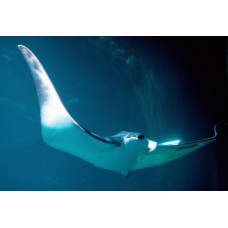Latin name
Mobula japanica
Other name
Spinetail devil ray or Japanese mobula ray.
Identification
The pectoral fins of the spinetail mobula, the base of which is behind the eyes, merge with the head to form a diamond-shaped flat disc, wider than long, with the edges of the fins pointed ("wings"). The head is broad and flat, with the eyes set at the sides. Behind the eyes, above the point where the pectoral fins enter the body, there are tiny semicircular spiracles. There is a spine at the base of the tail. The length of the slender, whip-shaped tail is much longer than the length of the disc. The base of the tail is flattened. The tail is covered longitudinally with well defined white tubercles. There are 5 pairs of gill slits, mouth and nostrils on the ventral surface of the disc.
Features of fish fins
The front part of the pectoral fins becomes the so-called dorsal fins. At the base of the tail is a small dorsal fin with a white tip.
Fish colouring
The dorsal surface of the disc is dark blue to black. The ventral surface is white. The outer edges of the head fins are silvery grey with black tips. A dark band runs between the eyes on the dorsal side of the disc. Behind the eyes there are lateral white markings.
Distribution
This species is found in temperate and tropical waters off the coasts of Australia (New South Wales, Queensland), Bangladesh, Brazil, Cambodia, China, Colombia, Costa Rica, Côte d'Ivoire, El Salvador, Fiji, Guatemala, Honduras, India, Indonesia, Japan, Korea, Mexico, Myanmar, New Zealand, Nicaragua, Oman, Pakistan, Panama, Peru, Philippines, Somalia, South Africa, Sri Lanka, Taiwan, Thailand, Tuvalu, USA (California, Hawaii), Vietnam and Yemen. They can be caught in the North Atlantic. Their presence in Australian waters has only recently been confirmed. The southern part of the Gulf of California serves as a natural nursery for these stingrays, where adults gather in spring and summer to mate and fatten.
Habitat
Subtropical marine species associated with reefs. Spinetail mobuls are pelagic and occur at depths of up to 200 metres.
Size
The maximum recorded width of the spinetail mobula disc is 310 cm, but on average it does not exceed 250 cm.
Behavior
These stingrays are found close to shore and in the open sea, and are kept both individually and in schools.
Food and feeding habits
The diet of these rays consists mainly of krill (mainly Nictiphanes simplex), copepods and crustacean larvae. They may also prey on small schooling fish. Acoustic evidence suggests that Spinetail Mobula spend time above the thermocline at night feeding on krill.
Reproduction
This species is an egg-laying fish. The embryos develop in the womb and feed on egg yolk and histotrophs. There is usually one newborn in a litter with a disc width of 70-85 cm. In Indonesian waters, males reach maturity at a disc width of 205-210 cm, and in the Gulf of California males and females reach maturity at a disc width of 210 cm and 207 cm respectively. Pups are likely to be born offshore around islands and submarine pinnacles far from the mainland.
Fishing
Spinetail mobula are fished commercially. They are often caught as by-catch in striped tuna fisheries.
Relationship with a person
Harmless. The gill rays of this species are highly prized, and their meat, cartilage and skin are also used.
| Classification | |
| Phylum | Chordata |
| Class | Chondrichthyes |
| Squad | Myliobatiformes |
| Family | Mobulidae |
| Genus | Mobula |
| Species | M. japanica |
| Features | |
| Conservation status | Endangered |
| Habitat | Pelagic |
| Life span, years | No information |
| Maximum body weight, kg | No information |
| Maximum length, cm | 310 |
| Sailing speed, m/s | No information |
| Threat to people | Edible |
| Way of eating | Predator |
Spinetail mobula
Tags: spinetail mobula


